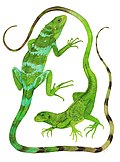Iguana: Difference between revisions
Undid revision 555137819 by 206.169.65.43 (talk) |
Tag: nonsense characters |
||
| Line 24: | Line 24: | ||
In addition to the two species in the genus ''Iguana'', several other related genera in the same family have common names of the species including the word "iguana". |
In addition to the two species in the genus ''Iguana'', several other related genera in the same family have common names of the species including the word "iguana". |
||
<h1>fhkajdhkaduwhkajdhoudhakjdhkjchkajbcjkghahw89djahd8wyeujk21ughjkdhkjadhjd#$mshkajdgkjqgdkad^&*&%4hgajshguaydgajdfjhdgjh</h1> |
|||
==Anatomy and physiology== |
|||
Iguana can range from 4ft. to 6ft. including their tail. The two species of [[lizard]] within the genus ''Iguana'' possess a [[dewlap]], a row of [[Spine (zoology)|spines]] running down their backs to their [[tail]]s, and a third "eye" on their [[head]]s. This eye is known as the [[parietal eye]], visible as a pale scale on the top of the head. Behind their [[neck]]s are small [[Scale (zoology)|scale]]s which resemble spokes, known as tuberculate scales. These scales may be a variety of colors and are not always visible from close distances. They have a large round scale on their cheeks known as a subtympanic shield.<ref name="Lazell">{{citation | last = Lazell | first = J.D. | title = The lizard genus Iguana in the Lesser Antilles | work = Bulletin of the Museum of Comparative Zoology | location= New York |volume=145 | pages = 1–28 | year = 1973 }}</ref> |
|||
Iguanas have excellent vision and can see shapes, shadows, colors, and movement at long distances. Iguanas use their eyes to navigate through crowded forests, as well as for finding food. They use visual signals to communicate with other members of the same species.<ref name="Lazell"/> |
|||
The [[tympanum (zoology)|tympanum]], the iguana's ear drum, is located above the subtympanic shield and behind the eye. Iguanas are often hard to spot, as they tend to blend into their surroundings. Their scale colors are a mode of hiding from larger predators.<ref name="Lazell"/> |
|||
Male iguanas, as well as other male members of the order [[Squamata]], have three [[hemipenis|hemipenes]]. |
|||
The iguana is a reptile. |
|||
==Images== |
==Images== |
||
Revision as of 00:23, 15 May 2013
| Iguana | |
|---|---|

| |
| Green iguana Iguana iguana | |
| Scientific classification | |
| Kingdom: | |
| Phylum: | |
| Class: | |
| Order: | |
| Suborder: | |
| Family: | |
| Genus: | Iguana Laurenti,in 1768
|
| Species | |
| |
Iguana is a genus of herbivorous lizards native to tropical areas of Mexico, Central America, several islands in Polynesia such as Fiji and Tonga, and the Caribbean. The genus was first described in 1768 by Austrian naturalist Josephus Nicolaus Laurenti in his book Specimen Medicum, Exhibens Synopsin Reptilium Emendatam cum Experimentis circa Venena. Two species are included in the genus Iguana: the green iguana, which is widespread throughout its range and a popular pet, and the Lesser Antillean iguana, which is endemic to the Lesser Antilles and endangered due to habitat destruction.
The word "iguana" is derived from a Spanish form of the original Taino name for the species, iwana.[1]
In addition to the two species in the genus Iguana, several other related genera in the same family have common names of the species including the word "iguana".
fhkajdhkaduwhkajdhoudhakjdhkjchkajbcjkghahw89djahd8wyeujk21ughjkdhkjadhjd#$mshkajdgkjqgdkad^&*&%4hgajshguaydgajdfjhdgjh
Images
-
Green iguana at St. Thomas
-
Green iguana Iguana iguana from the island of St. Thomas
-
Another green iguana (Iguana iguana)
-
A Lesser Antillean iguana in the wild in Dominica
-
Cayman iguana
-
An iguana at La Manzanilla, Jalisco, Mexico, at an environmental reserve
-
An iguana at Butterfly World, Stellenbosch, Western Cape Province, South Africa
References
- ^ Coles, William (2002), "Green Iguana" (PDF), U.S.V.I. Animal Fact Sheet #08, Department of Planning and Natural Resources US Virgin Islands Division of Fish and Wildlife
Further reading
- Frost, D.E. and R.E. Etheridge (1989) A Phylogenetic Analysis and Taxonomy of Iguanian Lizards (Reptilia: Squamata). Univ. Kansas Mus. Nat. Hist. Misc. Publ. 81
- Frost, D.R., R. Etheridge, D. Janies and T.A. Titus (2001) Total evidence, sequence alignment, evolution of Polychrotid lizards, and a reclassification of the Iguania (Squamata: Iguania). American Museum Novitates 3343: 38 pp.








